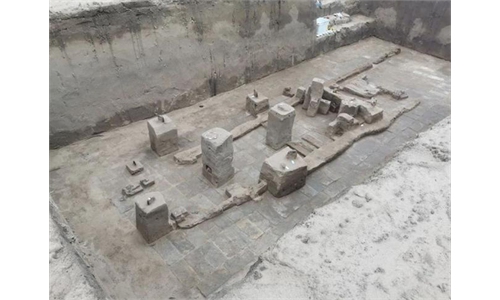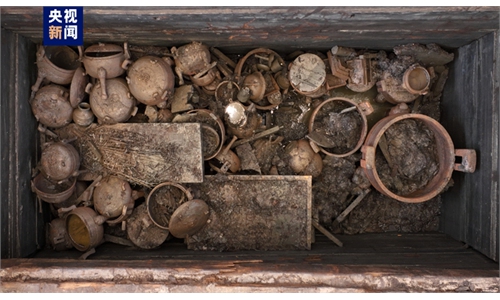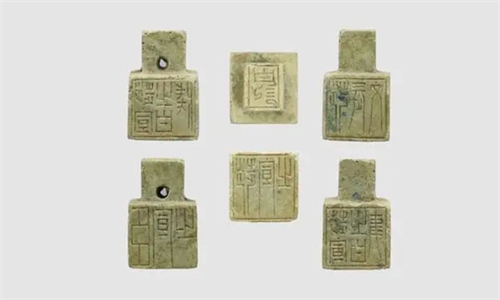ARTS / CULTURE & LEISURE
Archaeologists determine 2,200-year-old tomb belonged to King Kaolie of Chu state

The excavation site of the Wuwangdun tomb Photo:VCG
After completing fieldwork at the Wuwangdun No.1 tomb site in Huai'nan, East China's Anhui Province, archaeologists have determined the tomb's occupant was the late King Kaolie of Chu Kingdom, dating back to over 2,200 years ago, state broadcaster CCTV reported on Thursday.
The Wuwangdun cemetery, a large and independent burial site surrounded by a moat, covers approximately 1.5 million square meters.
Excavations at the No.1 tomb have yielded more than 10,000 artifacts. Based on the analysis of the No.1 tomb's scale, structure, unearthed artifacts, and inscriptions and cross-references with historical records, researchers were able to confirm the identity of its occupant.
The No.1 tomb is situated in the central area of the Wuwangdun cemetery, with a burial mound that rises about 14 meters high. The tomb's pit is a nearly square vertical shaft, measuring 51 meters on each side and 20 meters deep.
The burial chamber is divided into nine rooms, with the central room housing the main coffin. Surrounding this central coffin room are eight side chambers that contained various grave goods.
Notably, the wood used in the coffin chambers was inscribed with ink writing and corresponding carved symbols, indicating the placement of the coffin panels and the names of the side chambers. These inscriptions, uniform in format, represent the largest and most detailed collection of Chu ink writing discovered to date.
Among the most significant discoveries at the No.1 tomb is a top-tier set of ritual vessels and musical instruments, which offer crucial insight into the funerary practices of the Chu state. The musical ensemble in the tomb shows significant changes compared to high-ranking Chu tombs from the early to mid-Warring States Period (475BC-221BC), with large sets of bronze bells replaced by string and bamboo instruments, reflecting the evolution of Chu's ritual and musical culture during this time.
A burial system that "uses figurines in place of human sacrifices" was discovered in the No.1 tomb. The west side chamber contained 280 wooden figurines, with the first room likely serving as a ceremonial guard figurine room, housing over 80 figurines alongside lacquered wooden models of chariots and wooden models of swords and flutes.
The second room in the west side chamber appears to have been a music and dance chamber, with more than 200 figurines found alongside lacquered wooden models of chariots, zithers, and flutes. These well-preserved figurines, the largest and most diverse collection found in a Chu tomb, likely represent the tomb owner's ceremonial entourage and entertainment troupe in his afterlife.
"A large number of divination turtle shells were discovered in this tomb. This is the first time such a concentrated find has been made, and the underlying significance or the specific issues it might help resolve will require further in-depth research," lead archaeologist Gong Xicheng noted.
According to CCTV, the Wuwangdun cemetery has a clearly defined chronology and a well-preserved layout. The No.1 tomb is the most intact royal burial from the Zhou period (1046BC-221BC) and features the clearest arrangement of bronze ritual vessels and the most identifiable occupants. Its large scale, complex structure, and numerous artifacts offer rich historical information, serving as a benchmark for Eastern Zhou (770BC-256BC) archaeology.
The tomb is a vivid example of Chu culture and Eastern Zhou political systems, science, technology, customs, and arts, highlighting the remarkable achievements of Chinese civilization, said the CCTV report.



